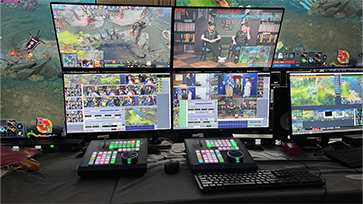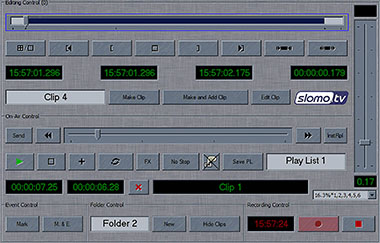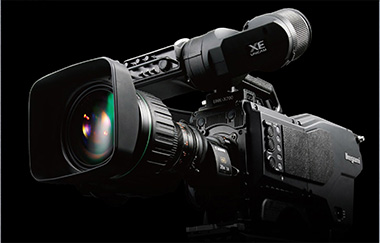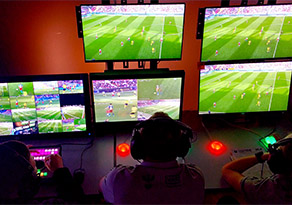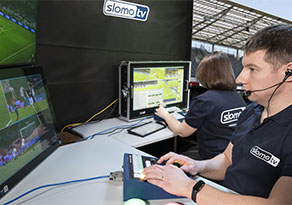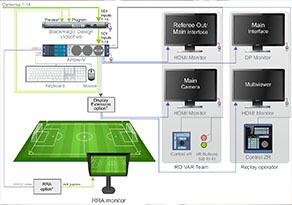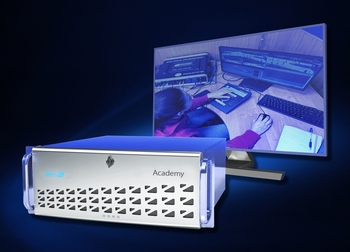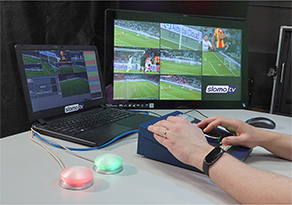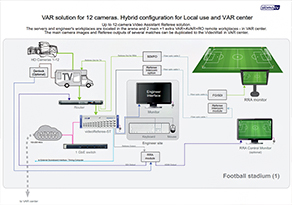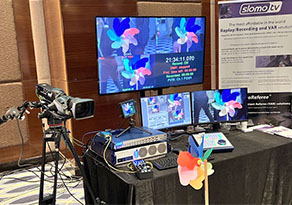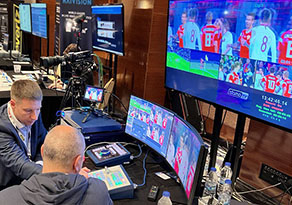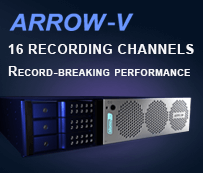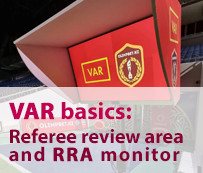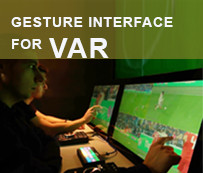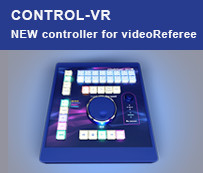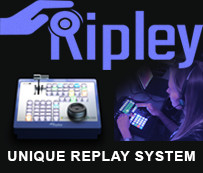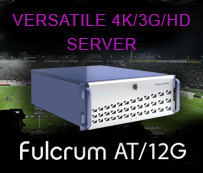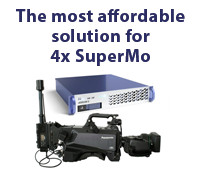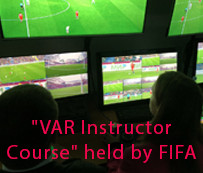- Details
After several years of testing, analyzing and refining the VR (Video Replay) system, EventsMedia Sp. z o.o. has provided a complete system for video support of referee decisions during the ORLEN Super League and ORLEN Polish Cup handball matches, both women's and men's, in the 2023/2024, 2024/2025 and 2025/2026 seasons.
A special team of experts selected from representatives of Superliga Sp. z o.o. and the team of referees of the Polish Handball Association defined very precise guidelines, requirements and expectations for the VR (VideoReplay) system for handball in Poland. The high bar meant that the best systems and technical solutions for this purpose had to be presented - they had to meet absolutely all the guidelines of the IHF regulations and take into account the specificity of handball competitions in Poland, the uniqueness of sports facilities and cooperation with TV broadcasters.
In response to the needs of this project, a team of experts from EventsMedia carried out a series of test matches, listening to the needs of the judges and jointly analyzing the possibilities and many alternatives of the system, in order to finally propose the use of optimal tools.
The final choice fell on world proven solutions from Slomo.tv and a dedicated video system to support refereeing decisions - videoReferee®. According to the integrator, the implementation of the system in each facility turned out to be trouble-free and the operation was exemplary. The judges greatly appreciated the intuitive 'user-native' interface, which allowed them to analyze the situation they were interested in within seconds, using all available camera angles or a selected camera, zooming in on the image via the touch screen and watching it in time-lapse. As a pioneer in the field of video refereeing, SLOMO.TV's entire range of specialized products can be found in every corner of the world in many sports disciplines, where we guarantee the highest quality in supporting refereeing decisions. Slomo.tv has been inextricably linked with handball since the IHF Handball World Championships 2017, where videoReferee® became the overall video judging system. Slomo.tv tried to be flexible in the testing process, so that EventsMedia could count on professional support from the structure of engineers of the department responsible for videoReferee® in the initial phase of the implementation.
- Details
The BetBoom Dacha Dubai 2024 offline tournament, organized by the FISSURE studio with the support of the general partner BetBoom bookmaker company, took place from 4 to 16 February at the One&Only Royal Mirage Hotel in Dubai. Presenting the first major LAN Dota 2 tournament of 2024, the event has become a highlight in the eSports calendar, capturing the attention of fans around the world.
12 top teams participated in the tournament: 7 invited teams (Team Spirit, Team Liquid, LGD Gaming, BetBoom Team, Aurora, Gaimin Gladiators, Xtreme Gaming) and 5 teams from the regional qualifiers (nouns – North America and South America, Virtus.pro – Eastern Europe, Azure Ray – China and Southeast Asia, OG – Western Europe, Team Falcons – Middle East and North Africa).
The group stage was played from 4 to 8 February 2024 in two round-robin groups of six teams each. All series consisted of two games. The top four teams from each group progressed to the upper bracket of the play-offs. The remaining teams were eliminated.
The playoffs were held from 11 February to 16 February 2024 with a double elimination bracket. All matches except the Grand Final were Bo3, the Grand Final matches were Bo5. There was also a solo tournament on the 10th of February, which was won by a Team Liquid member.
The length of a match was unregulated and ranged from 20 to 90 minutes. A total of 48 matches were played during the tournament.
The tournament was streamed in two languages on Twitch with 360,000 peak viewers, there was no live audience. The SLOMO.TV team took part in the technical preparations for the tournament. To support the broadcasts, two separate production teams were assembled, each using a Dominator AT/3G server.
There were two independent Replay Operator (RO) workstations running at 3G 59.94p per server:
- The 1st RO workplace had 2 channels for observers who controlled what was happening during the game and 10 channels (5 for each team) for cameras recording the emotions of the players. It produced instant replays and highlights of the game. After the end of the game, the highlights were reviewed for analysis, edited and exported to the second RO workplace.
- The 2nd RO workplace worked with 2 channels that recorded interviews for subsequent broadcasts.
Dominator AT server, used during the competition, is the latest generation of the multi-channel recording and slow motion replay servers, which is deservedly considered to be the most powerful 4K/3G/HD system on the market.
The high performance of this relatively small (4U - 56 cm, 20 kg) system makes the Dominator AT server convenient for integration into any environment. Notably, support for a large number of 3G channels makes Dominator AT the ideal solution for e-sports replays, as demonstrated by the recent BetBoom Dacha Dubai 2024.
- Details
Due to the growing number of requests, SLOMO.TV has successfully integrated its multichannel recording and replay servers with the Ikegami UHK-X700 camera at x6-x8 speeds.
Support for the largest number of SDI I/Os in the industry allows SLOMO.TV servers to work with high speed, high resolution, high frame rate cameras. In particular, the Dominator AT Series, the latest generation of the multi-channel recording and slow motion replay servers, is fully compatible with the UHK-X700, one of Ikegami's UNICAM XE 4K HDR camera systems.
Dominator AT is deservedly considered to be the most powerful 4K/3G/HD system in the market. Its versatile platform is designed to work with a large number of channels, provide slow motion instant replays and recording for non-linear editing of large-scale productions. Support for a large number of 3G channels makes it an ideal solution for replays in e-sports as well. The high performance of this relatively small size and weight system (4U - 56 cm, 20 kg) makes the Dominator AT server convenient for integration into any environment.
The Dominator AT servers are integrated with Super Slow Motion cameras from most manufacturers and support various modes – standard 2x, 3x, 4x, Xtra Motion 6x and HyperMotion. The number of required SDI inputs depends on the camera speed. For example, 3x cameras require 3 dedicated 3G SDI video inputs.
Dominator AT/12G has a 4K support option, which is activated remotely, if necessary. The 4K software license opens the 6 Rec + 6 Search + 2 Play + FX configuration in replay mode and up to 6 recording channels for NLE.
The Ikegami UHK-X700 integrated with SLOMO.TV servers is a camera that combines high signal quality with versatile connectivity. Weighing only 5 kg, the camera can be pedestal or tripod mounted or operated over the shoulder. Its front end comprises three 2/3-inch CMOS UHD sensors with a global shutter to minimize artefacts when shooting LED screens or scenes illuminated with flash or strobe lighting. The HFR option supports up to 2x speed in 4K and up to 8x speed in HD.
The UHK-X700 can output UHD/HD video formats simultaneously.
The camera system supports such standard video formats and frame rates as 3840x2160p, 1920x1080p, 1920x1080i and 1280x720p, for both 59.94 and 50Hz. This is effective when shooting fast-moving subjects such as in sports. With 4K 12G-SDI and 3G/HD-SDI output, the UHK-X700 can utilize a wide range of video devices as accessories to enhance its operational capabilities.
Support for up to x8 speeds in HD is essential for modern TV broadcasting and sports video refereeing.
As always, SLOMO.TV keeps up with the demand and offers the most efficient solutions. Stay tuned to SLOMO.TV for more updates!
- Details
Video refereeing requires active communication between all VAR team members and match officials on the pitch. This is usually achieved through the use of an external intercom system, which can be installed in a VOR, OB-van or VAR-center.
The challenge with using external intercoms is that they need to be reliably integrated into the VAR system and the overall communications network in order to function effectively while recording conversations on the protocol.
To simplify the communication system and reduce the number of components, we have developed SLS Intercom, a communication subsystem embedded directly into the videoReferee® server. The benefits of the SLOMO.TV intercom option:
- Fewer external components make the solution more economical. Also, the reliability of the integrated system is increased.
- Any USB or wireless Bluetooth headset is compatible with the system – both specialized professional intercom headsets and much more affordable and widely available basic computer headsets can be used. Moreover, VAR team members can use their own personal headset, which is particularly important in a post-pandemic world, as personal equipment is more hygienic and secure.
Up to 16 intercom users, both internal and external, can be connected to the SLS Intercom. A configurable, user-controlled intercom matrix allows groups of users to be arranged in a variety of interaction scenarios and switched quickly, just as in other high-end intercom systems.
One of the built-in intercom system controls is the red referee button included in the basic configuration of the videoReferee® server. In accordance with international officiating protocol, the VAR team can only communicate with the referee on the pitch by holding down the red referee button.
The SLS Intercom’s direct connection to the venue’s audio information system allows the referee on the pitch to make independent announcements in the arena.
The videoReferee® server and SLS Intercom can also be connected to a remote workplace, to make hybrid VAR solutions even more practical. Furthermore, the SLS Intercom allows users to connect to the situation room and VAR center directly via the server.
The SLS Intercom can be used not only in football, but also in hockey, basketball, and other sports, where a video refereeing system is used.
This new built-in intercom option for the SLOMO.TV videoReferee® systems is the perfect solution for sports organizations that want to get the ultimate functionality from one server without using external systems.
- Details
Nowadays, sports TV broadcasters are often required to provide VAR technology for game coverage. They are responsible for the quality of the video signals and the organization of the VAR team workspace. Broadcast engineers need to support the full functionality of the video equipment, including the VAR system.
At the same time, the broadcasters may have limited resources, both in terms of physical space and equipment. Often, all of the technical stuff and video equipment involved simply do not fit into the OB vans and VORs.
For organizers of a sporting event the video production is a significant expense, and with live coverage, there is a lot at stake. It is understandable that many TV companies are looking for a video system configuration able to help streamline the sports video production workflow while saving costs and space.
In response to the demand, SLOMO.TV presents its R-vR – a two-in-one solution that provides instant replay and video refereeing functions in one server. R-vR is a combination of SLOMO.TV instant replay system and FIFA-certified videoReferee®VAR.
Since 2007, SLOMO.TV produces cost-effective server-based solutions for 4K/3G/HD multi-channel recording, instant slow motion replays, live production as well as videoReferee® systems for sports video refereeing. Our extensive experience has led to the development of the fully functional R-vR hybrid solution.
This solution is expected to be of particular interest to football organizations, as the same cameras are typically used for both the TV broadcast and the VAR system during football matches.
The small size and light weight of the R-vR server makes it ideal for on-site broadcasting. The included flight case ensures that the system is portable and quick to set up. Moreover, R-vR consumes less power and is easier to connect and install in the arena than two separate servers.
The R-vR solution provides either 8 or 16 SDI I/O channels, supporting from 7 to 15 cameras. The replay and VAR system components share the same video signals and recording channels.
To optimize the overall workflow, the R-vR includes 2 completely independent workplaces - one for the replay operator and another for the VAR/video referee, each with 1 monitor. If necessary, the Display Extension Option adds 2 more monitors to the system for a total of 4.
Workplace for the replay operator:
In the simplest setup, the workplace is equipped with 1 monitor, Control-ZR control panel connected via USB, mouse and keyboard. The monitor is running the Multiskin function that allows switching between several interfaces on one monitor.
The replay operator can work with the Main Interface, where video clips are edited and marked up, or the Multiviewer, which is mainly used for instant replays. With the Display Extension Option, there can be 2 monitors, so the Main Interface and the Multiviewer are displayed separately.
Workplace of the VAR/video referee:
The basic workplace configuration features 1 monitor, Control-VR control panel, and up to 4 referee buttons to mark events and control communication with on the pitch match officials.
The monitor is fully functional for refereeing tasks, displaying both live and delayed video feeds, and can switch between Referee Out/Main Interface and Main Camera via Multiskin.
If the second monitor is connected, the Main Camera and the Referee Out/Main Interface can be displayed separately.
If required, clips can be quickly exported through the Referee Out/Main Interface at the end of the match.
For football matches, the R-vR solution can include the RRA option, which allows the VAR interface showing the review in progress to be transmitted to the RRA monitor. When the VAR interface is absent, the monitor displays a background image. The RRA also automatically transmits referee decisions data to Venue Information Graphics systems.
To further simplify the video refereeing workflow in many sports (basketball, hockey, handball, wrestling, etc.), the R-vR server can be complemented with a wireless monitor option that transmits the referee’s interface to a tablet. Any iOS or Android tablet can be connected to the R-vR system via Wi-Fi and used as a wireless RRA monitor, saving significant time in the officiating process.
With a range of options to meet the TV production and video judging needs of various sports, the R-vR configuration is an excellent solution for broadcasters, football leagues, and sports organizations that value resource conservation and equipment portability.
- Details
SLOMO.TV showed an original video advert featuring its Remote Production, VAR University and Goal-Line Replay solutions at SVG Europe Football Summit 2024.
Nadezhda Gretskaya, Global Sales Manager at SLOMO.TV, was representing the company at the event, which took place in Belgium on 29 February. The EGG conference center in Brussels hosted the Football Summit this year.
Find out about SLOMO.TV most recent features:
- Details
The active implementation of VAR systems has significantly improved the quality of refereeing in football. It is now mandatory for top referees officiating in international competitions to be able to work with VAR systems.
Although VAR has started to spread actively since 2018, many countries still do not have it. There is often a fear of VAR implementation. Many see it as a complex and lengthy process. The financial component is also significant – the equipment, installation process and training are perceived to be quite expensive
Through many successful VAR implementations in various football leagues and federations, we have gained experience in doing what is usually considered impossible - installing VAR systems quickly, efficiently and cost-effectively. We have affordable, yet powerful, certified equipment, our own training technology and a tried and tested methodology.
We also believe that the spread and development of VAR would be facilitated if there were specialized regional centers that could provide training for VAR teams and provide a space for professional-level communication between all those involved in the officiating process (referees, VARs, AVARs, ROs).
By combining all of our knowledge and technological expertise, we are able to offer a complete SLOMO.TV VAR University solution that makes it as easy as possible for leagues and associations to create their own regional VAR training centres. It allows anyone working under the VAR University franchise to get up and running quickly and then continue to promote VAR without our involvement.
VAR University is a unique way to enhance the image and status of a football league that creates an educational center based on the franchise. This is also a business opportunity where the customer becomes a training provider themselves.
VAR University comprises:
- Hardware complex
VAR University is primarily based on Starter Kit – a compact, protective rack case solution that includes videoReferee® server (8-16 channels), Academy server (8-16 channels) and RRA option.
Starter Kit is self-contained. It requires only 4 to 8 standard computer monitors and a power supply to operate and to deliver group training sessions. Starter Kit rack can also be used as a VAR system for live matches. Portable and easy to transport, it can be used to train VAR teams on the field in a live environment or to warm up referees before important matches. - Original methodology
We provide comprehensive training – starting with the VAR basics and progressing to working on live matches. Our training system makes it simple to develop and maintain the necessary skills for the entire VAR staff, regardless of their starting level. A dedicated training center also helps the VAR team learn how to interact with the referee on the pitch in accordance with the VAR protocol. - Training materials
The Academy server contains various training videos from past live events, covering controversial moments. It is also possible to add new training clips, enabling continuous growth of all VAR personnel based on new material and knowledge.
VAR University makes the creation of a regional training center a reality for football associations and leagues around the world. Become a VAR training and implementation hub for the neighboring countries with SLOMO.TV!
- Details

SLOMO.TV’s Remote Production, VAR University and Goal-Line Replay solutions will be featured in the company’s Video Ad that will be shown throughout the summit.
Nadezhda Gretskaya, Global Sales Manager at SLOMO.TV, will represent the company at the event, which will take place in Belgium on 29 February. The EGG in Brussels is hosting the Football Summit this year.
Feel free to contact Nadezhda if you have any questions or suggestions. SLOMO.TV is always open to new collaborations and bright ideas. See you in Brussels this Thursday!
- Details
Broadcasters today face a staggering lack of resources – financial, equipment and human. Even large companies are struggling, and for smaller TV productions, participating in the market today is even more daunting. Many different constraints arise from resource scarcity.
For example, for a broadcaster using a standard OB van it is sometimes impossible to provide dedicated workstations for two or three replay operators. Renting or outfitting a larger OB van with enough workstations requires a significant investment.
Another common situation is that a replay operator usually needs to travel to a distant broadcast location, so it's impossible to get the same operator to cover different events in different areas on the same day. As a result, the TV company has to employ more operators and fund their business trips to the production sites every time there is an event to be broadcast, which is quite costly.
To provide a solution to many of the challenges posed by scarce resources, SLOMO.TV offers a new remote production option that allows operators to work over the Internet while being physically distant from the server. The new feature is available on all modern systems and only requires an internet connection.
For replay, video refereeing and VAR systems, it is critical that the remote interface ensures low latency and fast response. Software developed by SLOMO.TV provides a delay of just 0.1 sec for remote production over long distances without the need for external devices or third-party software. The software itself is a thin client that runs on any average modern PC.
There are a lot of possible applications for remote production:
- Separation of the equipped OB van from the staff – the server can be installed in the OB van and the production crew's workplaces can be in a nearby room, event venue, or their own homes, as long as there is a stable internet connection.
Running the workflow over the internet means there is no need to spend extra money on a larger OB van or staff travel. With remote production, fewer operators are needed, as a single specialist can cover multiple events at different venues on the same day.
As the most compact systems in the world, SLOMO.TV servers also free up space in the OB van for other equipment, allowing the use of smaller vehicles. - Hybrid VAR solution. The hybrid solution allows the Video Operation Room (VOR) and VAR team workstations to be set up outside the competition venue, wherever a stable broadband internet connection is available, while the server remains in place.
The VAR team can use the control panel, the referee buttons, the keyboard and the mouse to manage the system from the remote VOR or from the VAR center. If there are additional monitors available, the server can transmit not only the operator interface, but also a Multiviewer and the Main Camera, making the remote VOR fully functional. - Sports league supervisors can now work independently of the arena and VAR center staff with the user interface connected to their office computer, PC or laptop.
The supervisor's PC becomes the 2nd/3rd/4th remote workplace running on the SLOMO.TV video server installed at the competition venue. League supervisors can interact with the video feed like any other fully functional user, without interfering with the work of the arena and VOR staff. - The possibility of remote Academy training.
Today, due to a lack of educational resources, there is a shortage of broadcasting professionals. Academy is our system-based solution for the development and growth of your broadcast team.
Trainees can connect to our Academy server, which provides training and educational materials necessary to master the competencies of a TV production or VAR team member. SLOMO.TV instructors are available online to help you learn how to operate our systems. All you need to use the Academy at home or in the office is the control panel and a PC connected to the internet. - There is no need to travel to the SLOMO.TV office to get a demo of our systems anymore. An online demonstration option allows the customer to test our key system features while being guided by our specialists.
The rapid evolution of remote workflows has been underway for several years, and the pandemic unexpectedly helped to accelerate the creation of the necessary infrastructure in various industries, including TV production. The use of remote production for both TV broadcasting and video refereeing is a cost-effective solution without sacrificing quality or operational speed.
- Details
SLOMO.TV, an international provider of affordable and powerful broadcast-grade multi-channel recording and replay servers, took part in the recent AVITENG Tech Days 2023 exhibition held in Turkey with a demonstration of the Arrow III server and Dream Chip AtomOne SSM500 camera integration at the company’s stand.
Just a few years ago, super slow-motion cameras weren't as common as they are today. Nowadays, the presence of Super Slow Motion cameras is moving from desirable to mandatory for broadcasting not only sports competitions, but also any other major events.
It usually requires a substantial investment to acquire SSM cameras and compatible servers. SLOMO.TV has proven that SSM can be truly accessible: the Arrow III server integrated with the Dream Chip AtomOne SSM500 camera provides a 2x, 3x, 4x Super Slow Motion budget solution for broadcasting that can handle both basic and complex tasks.
The self-contained powerful 2U replay server Arrow III is compact, mobile and affordable for most broadcast companies. It is suitable for broadcasting live events, sports video-refereeing (football, hockey, basketball, water polo, handball, wrestling, canoe slalom, etc.) and recording for NLE of TV programs.
The Arrow series servers are seamlessly integrated with SSM cameras from most manufacturers, providing support for 2x, 3x, 4x SuperMo, as well as Xtra Motion 6x and HyperMotion cameras. The number of required SDI inputs depends on the shooting speed of the camera.
The AtomOne SSM500 camera by Dream Chip has an excellent image quality, converges with other television cameras in all image transmission parameters, and has a continuous recording feature, which greatly benefits the broadcast workflow. The SSM500 is available with either a C-Mount or a B4-Mount. Due to the small size of the Dream Chip AtomOne SSM500 camera (190mm x 60mm x 60mm), it can be installed where it is impossible to use a standard television camera, including on small cranes.
Extensive experience with Super Slow Motion cameras has allowed SLOMO.TV specialists to implement an intuitive user-native interface designed specifically for the setup and management of such cameras, including smooth speed adjustment. All the main parameters of the SSM500, such as color correction, white balance, exposure, can be configured via the SLOMO.TV server interface. It is also possible to connect an additional RCP (Remote Control Panel) for special fine-tuning.
Networking support with the ability to share clips and playlists between servers, included in the basic package of all SLOMO.TV solutions, makes it easy to expand the hardware complex and increase the number of channels for both standard and super slow-motion cameras used for broadcasting.
The Arrow III server integration with the AtomOne SSM500 camera is an exemplary illustration of the optimal cost-effective solution for the companies that would like to enter the Super Slow Motion market without compromising quality.



